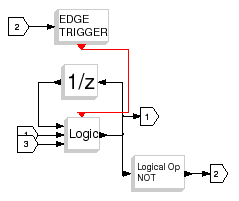Please note that the recommended version of Scilab is 2026.0.0. This page might be outdated.
See the recommended documentation of this function
JKFLIPFLOP
JK flip-flop
Block Screenshot

Contents
Palette
Description
The JK flip flop is the most versatile of the basic flip-flops. It has two inputs traditionally labeled J and K. When J and K are different, the output takes the value of J at the next falling edge. When J and K are both low, no change occurs in the output state, when they are both high the output will toggle from one state to other. It can perform the functions of the set/reset flip-flop and has the advantage that there are no ambiguous states. It can also act as a T flip-flop to accomplish toggling action if J and K are tied together. This toggle application finds extensive use in binary counters. This block is almost used with digital number, the input data type is int8.
The truth table of this block is
| J | K | Q(t) | !Q(t) |
| 0 | 0 | Q(t-1) | !Q(t-1) |
| 0 | 1 | 0 | 1 |
| 1 | 0 | 1 | 0 |
| 1 | 1 | !Q(t-1) | Q(t-1) |
Dialog box

Initial Value
Initial Value of the state Q.
Properties : Type 'vec' of size 1.
Default properties
always active: no
direct-feedthrough: yes
zero-crossing: no
mode: no
regular inputs:
- port 1 : size [1,1] / type 5
- port 2 : size [1,1] / type 1
- port 3 : size [1,1] / type 5
regular outputs:
- port 1 : size [1,1] / type 5
- port 2 : size [1,1] / type 5
number/sizes of activation inputs: 0
number/sizes of activation outputs: 0
continuous-time state: no
discrete-time state: no
object discrete-time state: no
name of computational function: csuper
Interfacing function
SCI/modules/scicos_blocks/macros/IntegerOp/JKFLIPFLOP.sci
Compiled Super Block content

Authors
Fady NASSIF - INRIA
| << INTMUL | Integer palette | LOGIC >> |